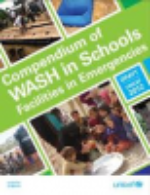
Compendium of WASH in schools facilities in emergencies
Unicef
Review, English, 88 pages
Summary
The purpose of this compendium is to collate knowledge on emergency interventions that deliver WASH-related health benefits while minimizing disruption to education opportunities. By sharing information on equipment and designs for temporary learning spaces/schools, this compendium will enable WASH and education staff to:
- Enhance preparedness measures for schools and temporary learning spaces before a crisis.
- Base emergency responses on adaptation of previous experience, using this information to help design new facilities.
- Implement early recovery and transitional interventions that complement permanent, long-term development.
- Carry out basic planning to coordinate WASH in Schools activities.
Construction must be linked with ‘software’, i.e., hygiene promotion and behavioural change. During emergencies, hygiene promotion in schools/temporary learning spaces will be supported by communitybased programmes where they exist. In the school or learning environment, teachers and learners are the primary stakeholders who will use and maintain WASH facilities, within limitations due to age and specialized maintenance tasks. The compendium complements UNICEF’s ‘Water, Sanitation and Hygiene for Schoolchildren in Emergencies: A Guidebook for Teachers’. The guidebook is designed for those involved in teaching and working with children in emergency preparedness, during an emergency and throughout the recovery period. It provides simple strategies for use and adaptation with all children and families to ensure a smooth transition to a healthy and accessible learning environment.
Publication Year
2012
Topic
WES references | Water supply | Emergency water supply | Sanitation & Hygiene | Sanitation Hardware | Sanitation in Schools | Emergency
